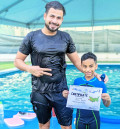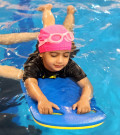
Adult Swimming Dive into a Healthy Lifestyle
2024-02-09 - swimmingSwimming isn't just for kids; it's a fantastic activity for
adults too. Whether you're looking to improve your fitness, relax, or even
compete, diving into the world of adult swimming can offer a myriad of benefits
for your physical and mental well-being.
Physical Health Benefits
Swimming provides a full-body workout without putting stress
on your joints. It improves cardiovascular health, tones muscles, and enhances
flexibility. Moreover, regular swimming can help in weight management and
reduce the risk of chronic diseases like heart disease and diabetes.
Mental Health Benefits
Beyond physical health, swimming has significant mental
health benefits. The rhythmic nature of swimming, coupled with the feel of
water, can be incredibly calming and stress-relieving. It boosts mood, reduces
anxiety, and promotes overall mental well-being.
Social Benefits
Swimming isn't just a solitary activity. It provides
opportunities to socialize and connect with others, whether it's joining a swim
club or simply chatting with fellow swimmers at the pool. Building these social
connections can enhance your overall quality of life.
Overcoming Fear of Swimming
Many adults have a fear of swimming, often stemming from
childhood experiences or lack of exposure to water. However, overcoming this
fear is possible with patience and practice. Starting with basic water safety
skills and gradually building confidence in the water can help conquer this
fear.
Finding the Right Swimming Facility
Choose a swimming facility that suits your needs and
preferences, whether it's a local pool, community center, or gym. Ensure the
facility maintains proper safety and cleanliness standards.
Choosing the Right Swim Gear
Invest in high-quality swim gear, including swimsuits,
goggles, swim caps, and appropriate footwear. Comfortable and well-fitted gear
can enhance your swimming experience and performance.
Basic Swimming Techniques for Adults
Floating and Breathing Techniques
Learning to float and control your breathing is fundamental
to swimming. Practice floating on your back and front, focusing on relaxation
and breath control. Mastering these skills lays the foundation for further
swimming proficiency.
Learning Different Strokes
Explore various swimming strokes such as freestyle,
breaststroke, backstroke, and butterfly. Start with the stroke that feels most
comfortable and gradually incorporate others into your repertoire as you gain
confidence and skill.
Advanced Swimming Techniques and Skills
Perfecting Stroke Efficiency
Focus on refining your swimming strokes for maximum
efficiency and propulsion. Pay attention to body position, arm movement,
kicking technique, and breathing coordination to optimize your swimming
performance.
Improving Endurance and Speed
Gradually increase the duration and intensity of your
swimming sessions to build endurance and speed. Incorporate interval training,
drills, and resistance exercises to challenge yourself and push your limits.
Incorporating Swimming into Your Fitness Routine
Setting Realistic Goals
Set achievable goals based on your fitness level, swimming
experience, and personal objectives. Whether it's swimming a certain distance,
improving technique, or participating in a swim event, having clear goals can
keep you motivated and focused.
Creating a Structured Swimming Plan
Develop a structured swimming plan that includes regular
sessions, rest days, and cross-training activities. Consistency is key to
progress, so commit to a realistic schedule that fits into your lifestyle.
Safety Precautions for Adult Swimmers
Understanding Pool Safety Rules
Familiarize yourself with pool safety rules and guidelines
to ensure a safe swimming environment. Pay attention to signs, depth markers,
and designated swim areas to prevent accidents and injuries.
Importance of Supervision
Swim in designated areas supervised by lifeguards or
experienced swimmers, especially if you're a beginner or swimming in open
water. Never swim alone, and always inform someone of your swimming plans.
Dealing with Common Swimming Injuries
Be aware of common swimming injuries such as muscle strains,
shoulder impingement, and swimmer's ear. Take precautions like warming up,
using proper technique, and seeking medical attention for any discomfort or
injury.
Overcoming Plateaus and Challenges
Dealing with Boredom
Combat boredom by incorporating variety into your swimming
routine. Try different strokes, drills, and workouts to keep things interesting
and challenging. Swimming with a partner or joining group classes can also add
excitement to your sessions.
Breaking through Skill Plateaus
Plateaus are a natural part of skill development. Break
through plateaus by setting new goals, seeking feedback from instructors or
peers, and experimenting with different training methods. Stay patient and
persistent, and progress will follow.
Visualization Techniques
Visualize success and mentally rehearse your swimming
performance before competitions or challenging workouts. Visualization can
enhance confidence, focus, and performance under pressure.
Building Confidence
Believe in yourself and your abilities as a swimmer. Focus
on your strengths, celebrate progress, and learn from setbacks. Cultivate a
positive mindset that fuels your motivation and determination to succeed.







.jpg)











































































































































































































